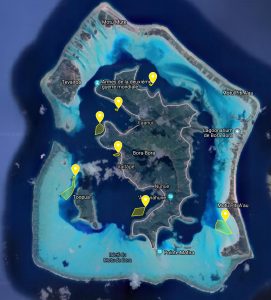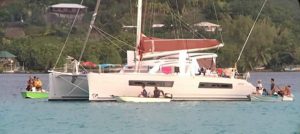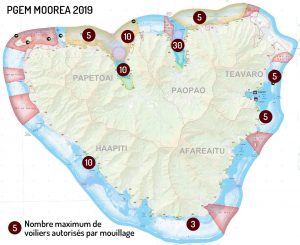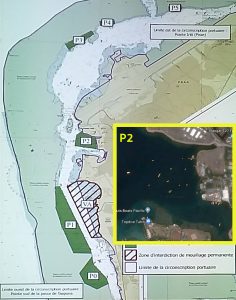The AVP is concerned about a recent evolution towards restricting the conditions of stay of sailboats in French Polynesia.
For the last few months, one has witnessed a whole series of constraints, prohibitions, even violent actions towards the sailing community:
 In Bora Bora, total prohibition to anchor, even on sandy grounds (sole available areas in green on the chart below). Obligation to take a mooring for 3000 xpf/night, without any guarantee the mooring is safe, as proven in the case of catamaran “Archer” which broke its lines, suffered considerable damage as did the pontoon of the Pearl Beach Hotel it ended up against. The boat’s insurance had to cover these damages, but the moorings concession holder (“BBMS”) refuses to answer the boat’s insurance queries, and notably confirm whether he is insured or not. (as of 11/11/2019).
In Bora Bora, total prohibition to anchor, even on sandy grounds (sole available areas in green on the chart below). Obligation to take a mooring for 3000 xpf/night, without any guarantee the mooring is safe, as proven in the case of catamaran “Archer” which broke its lines, suffered considerable damage as did the pontoon of the Pearl Beach Hotel it ended up against. The boat’s insurance had to cover these damages, but the moorings concession holder (“BBMS”) refuses to answer the boat’s insurance queries, and notably confirm whether he is insured or not. (as of 11/11/2019).
 In Raiatea, several yachts were insulted, menaced, and in at least one instance attacked in the Miri Miri area. One of the catamarans (“Tao”) had its anchor line cut – while the owner of the yacht was filming the deeds. A police report was filed, but was not followed up by the Attorney General (as of 11/11/2019). The DPAM (Maritime Affairs Department has informed the AVP, without showing any legal documents to that effect, that in fact anchoring was illegal throughout Polynesia and that regulations were being drafted to confirm these prohibitions wherever required.
In Raiatea, several yachts were insulted, menaced, and in at least one instance attacked in the Miri Miri area. One of the catamarans (“Tao”) had its anchor line cut – while the owner of the yacht was filming the deeds. A police report was filed, but was not followed up by the Attorney General (as of 11/11/2019). The DPAM (Maritime Affairs Department has informed the AVP, without showing any legal documents to that effect, that in fact anchoring was illegal throughout Polynesia and that regulations were being drafted to confirm these prohibitions wherever required.
 In Moorea, a “PGEM” will shortly be put in place (General plan for the maritime area):
In Moorea, a “PGEM” will shortly be put in place (General plan for the maritime area):
-> Prohibition to anchor outside area defined by the PGEM.
-> Prohibition to exceed the quotas allocated to each area.
-> 83 boats maximum allowed over the entire Moorea lagoon.
-> 50% of these allowed anchorages will be well inside the bays (Cook and Oponohu) in 25 to 35m of water.
-> Most allowed areas are on the Northern side of the island, where the sandy areas are the smallest and where hence the risk of damaging flora and fauna are the highest and where the concentration of housing and touristic activities are highest.
-> 48 hours maximum allowed in any one location.
-> Only 13 boats will be allowed on the Eastern side of the island, the only one likely to be accessible reasonably by sailboats coming from Tahiti for the limited 48h allowed. Moorea has over 50 resident sailboats on this side of the island, and Tahiti over 250 resident sailboats.
-> These areas will be used by the sailboats from marina Vaiare in Moorea for their week-end outings.
-> These quotas will be reviewed annually unilaterally by the commission.
 In Tahiti, the Taina area is due to be “evacuated”. Some 63 boats were there on November 4th, more than 80 in high season. Some are wrecks, but most are in perfect state, and are either transient boats, awaiting spare parts or on provisioning runs or boats parked there more permanently. This technical stop is absolutely indispensable for all boats in transit after a long passage. Taina is home to a marina (full), a fixed mooring field (full) and an area of tolerated anchorage, which now is being cleared.
In Tahiti, the Taina area is due to be “evacuated”. Some 63 boats were there on November 4th, more than 80 in high season. Some are wrecks, but most are in perfect state, and are either transient boats, awaiting spare parts or on provisioning runs or boats parked there more permanently. This technical stop is absolutely indispensable for all boats in transit after a long passage. Taina is home to a marina (full), a fixed mooring field (full) and an area of tolerated anchorage, which now is being cleared.
The minister in charge of this issue proposes to relocate some of these boats to Taravao (on the Southern end of Tahiti, some 40 miles away!), perhaps in a new marina that may be built a few years down the road (!), and meanwhile in zones P2 to P5 below in areas without landing facilities, and in any case catering to less than 60% of the boats concerned.
—> P3,P4 and P5: No landing possibilities at all, less than 1.5m depth and already occupied by small crafts used as party boats.
—> P2: Vaitupa Bay, already saturated as shown in the satellite picture below.
The increase in the number of yachts since the rules of stay were changed 5 years ago has led to some degree of rejection from the local population. Some elected members of Parliament have indicated their intention to legiferate in order to prohibit the lagoon on the Southern side of Tahiti and thereby avoid the migration of boats towards this area, quite in opposition of what the Minister indicated.
All existing infrastructure of the territory is saturated: Marina Taina, Marina Papeete, Marina Apooiti in Raiatea, , Yacht Club in Tahiti, Marina Vaiare in Moorea, Taravao, Raiatea mooring fields all full and will not be able to receive the yachts being removed following the prohibition to anchor.
The AVP points to the fact that the nautical tourism has been earmarked as a strategic component in the economic development of French Polynesia, towards which it contributes over 1.5 billion CFP today.
Aiming at increasing this contribution further, the government has chosen to increase the number of sailboats by lengthening the allowed duration of stay and by decreasing the import tax for boats to some 7% (June 2014).
However, against this increase, no new infrastructure has been put in place, leading to a significant concentration of yachts on anchor in all islands, and generating the relative rejection by locals today.
The AVP is a non profit organization founded and run by sailors, both transient and resident. Its charter includes:
- Promote the image of the sailing community
- Defend sailors rights
- Educate sailors to all existing regulation and good practices, in particular environmental and cultural.
- Provide practical information regarding anchorages, infrastructure, suppliers and services to facilitate the stay of transient boats and the general well being of all concerned.
Contact: http://voiliers.asso.pf avp.tahiti@gmail.com 87 70 36 15 Arnaud JORDAN





